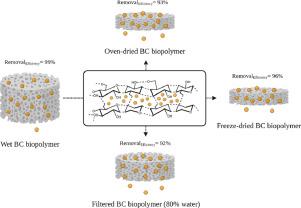Water Research ( IF 11.4 ) Pub Date : 2022-08-05 , DOI: 10.1016/j.watres.2022.118952 Marisa Faria 1 , César Cunha 2 , Madalena Gomes 2 , Ivana Mendonça 2 , Manfred Kaufmann 3 , Artur Ferreira 4 , Nereida Cordeiro 1

|
Microplastics (MPs) pollution has become one of our time's most consequential issue. These micropolymeric particles are ubiquitously distributed across all natural and urban ecosystems. Current filtration systems in wastewater treatment plants (WWTPs) rely on non-biodegradable fossil-based polymeric filters whose maintenance procedures are environmentally damaging and unsustainable. Following the need to develop sustainable filtration frameworks for MPs water removal, years of R&D lead to the conception of bacterial cellulose (BC) biopolymers. These bacterial-based naturally secreted polymers display unique features for biotechnological applications, such as straightforward production, large surface areas, nanoporous structures, biodegradability, and utilitarian circularity. Diligently, techniques such as flow cytometry, scanning electron microscopy and fluorescence microscopy were used to evaluate the feasibility and characterise the removal dynamics of highly concentrated MPs-polluted water by BC biopolymers. Results show that BC biopolymers display removal efficiencies of MPs of up to 99%, maintaining high performance for several continuous cycles. The polymer's characterisation showed that MPs were both adsorbed and incorporated in the 3D nanofibrillar network. The use of more economically- and logistics-favourable dried BC biopolymers preserves their physicochemical properties while maintaining high efficiency (93–96%). These polymers exhibited exceptional structural preservation, conserving a high water uptake capacity which drives microparticle retention. In sum, this study provides clear evidence that BC biopolymers are high performing, multifaceted and genuinely sustainable/circular alternatives to synthetic water treatment MPs-removal technologies.
中文翻译:

细菌纤维素生物聚合物:水污染微塑料的可持续解决方案
微塑料 (MPs) 污染已成为我们这个时代最严重的问题之一。这些微聚合物颗粒普遍分布在所有自然和城市生态系统中。目前污水处理厂 (WWTP) 的过滤系统依赖于不可生物降解的基于化石的聚合物过滤器,其维护程序对环境有害且不可持续。由于需要开发用于 MPs 水去除的可持续过滤框架,多年的研发导致了细菌纤维素 (BC) 生物聚合物的概念。这些基于细菌的天然分泌聚合物在生物技术应用中表现出独特的特性,例如直接生产、大表面积、纳米多孔结构、生物降解性和实用的循环性。勤奋,流式细胞仪等技术,扫描电子显微镜和荧光显微镜用于评估 BC 生物聚合物对高浓度 MPs 污染水的去除动力学的可行性和表征。结果表明,BC 生物聚合物对 MPs 的去除效率高达 99%,在几个连续循环中保持高性能。聚合物的表征表明 MPs 既被吸附又被纳入 3D 纳米纤维网络。使用对经济和物流更有利的干 BC 生物聚合物可以保持其物理化学性质,同时保持高效率 (93-96%)。这些聚合物表现出出色的结构保存性,保存了驱动微粒滞留的高吸水能力。总之,这项研究提供了明确的证据表明 BC 生物聚合物具有高性能,











































 京公网安备 11010802027423号
京公网安备 11010802027423号